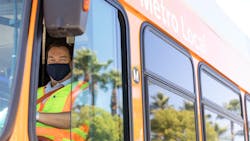L.A. Metro Board approves development of fareless test program
Development of a fareless pilot program was approved by the Los Angeles County Metropolitan Transportation Authority (L.A. Metro) Board of Directors.
The program aims to benefit students and low-income riders and to determine whether fareless transit could be expanded to more riders.
In approving a motion with a friendly amendment by a 12 to 0 vote, the L.A. Metro Board made clear that several conditions must be met before a fareless test program can be launched. Among those include the completion of a final funding plan and assurances that the pilot program would not impact L.A. Metro’s service or ability to keep its transit system in a State of Good Repair.
For now, there is no official start date for the fareless program.
L.A. Metro notes many transit agencies around the world are mulling fareless programs to provide mobility to those who need it most. Fareless is also seen as a way to pursue other worthy societal goals — such as reducing greenhouse gases by giving people an incentive to drive less.
When the test program goes forward, L.A. Metro says it will likely be the largest transit agency in the world to put such a large test program into action. In the region, the impetus for the program is glaring. About 70 percent of L.A. Metro’s riders are considered low-income (meaning their annual income is less than $35,000) and the fareless program would help fulfill the agency’s pledge to put equity at the forefront of its mission to improve mobility for all in our region.
The fareless program would also directly benefit many of the people most economically impacted by the COVID-19 pandemic and who most depend on L.A. Metro to get around. During the pandemic, L.A. Metro retained a higher percentage of riders than many other large transit agencies.
A team of L.A. Metro staffers have been studying fareless transit since last September and have found abundant evidence that putting money back into peoples’ pockets matters — a lot. In addition to the bleak household incomes for many riders, an estimated 69 percent of K-12 students in L.A. County are low-income.
Surveys suggest that about 75 percent of the county’s community college students who ride transit are also low-income. Introducing students to transit could also help students connect with educational, cultural and recreational opportunities.
The overall goal of the test program is to determine whether it’s possible for L.A. Metro to go fully fareless in the future. The test program would provide data and other insights needed to make that decision. The board has the discretion to terminate the program at the conclusion of the pilot if long-term federal or state funding commitments are not secured.
The board focused on the issue of how to pay for a fareless test program. L.A. Metro staff had earlier estimated that a 23-month pilot program could cost about $321 million, including local and municipal operators—a number many on the board found concerning.
As a result, L.A. Metro staff will continue to explore funding scenarios, including state and federal grants (Congress is considering new legislation to support fareless transit initiatives around the country) and contributions from schools, sponsors and/or stakeholders.
Another big issue that needs to be worked out is how the other local bus agencies in L.A. County could participate in a fareless program and exactly how that would be funded.
Some other important details:
- Current L.A. Metro daily ridership is about half of the 1.2 million daily boardings L.A. Metro served in 2019. As the pandemic eases, it expects ridership will grow but there will still be ample capacity for returning and new riders when the pilot program launches.
- Vaccinations are now widely available to anyone 12 or older and L.A. Metro requires all riders to wear masks. It believes that getting vaccinated and wearing a mask makes riding transit extremely safe.
- Since L.A. Metro launched its fareless study last summer, the agency has heard from plenty of riders and stakeholders—a survey earlier this year received 46,400 responses with 86 percent of riders supporting fareless and 80 percent of non-riders also supporting it.
- Stakeholders have concerns, namely impacts of going fareless on safety, operations, cleanliness and the number of homeless riding the system.
- L.A. Metro says it takes those concerns very seriously and the agency has several initiatives underway as part of its recently released Customer Experience Plan. These include increasing staff presence at facilities and on vehicles, elevator attendants at stations, adding blue light call boxes and continued efforts to connect homeless people to social services and shelters.
- L.A. Metro CEO Phil Washington—whose last day at the agency was May 27—first called for staff to begin developing a fareless plan last August. Many observers said the fareless study is testament to Washington’s work at L.A. Metro over the past six years to expand access to opportunity for riders and residents.
